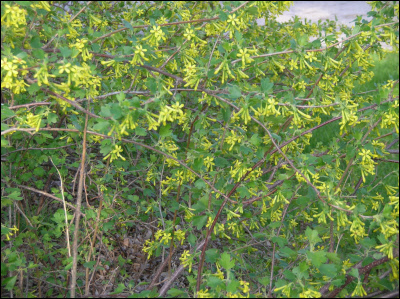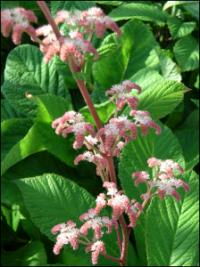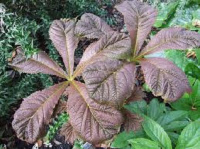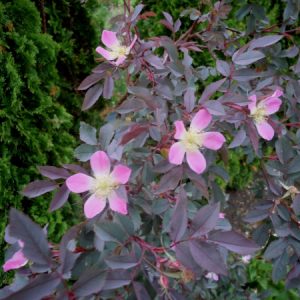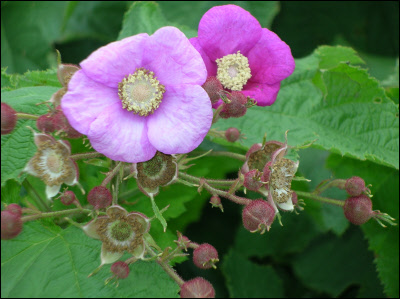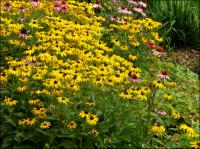Our Plants
Showing 465–472 of 587 results
-
Ribes aureum syn. Ribes odoratum Clove currant Z 3-8
Early to mid-spring yellow flowers shaped like a tube with 5 petals opening wide at the ends smother the shrub giving off a sweet, clove-scented fragrance – heavenly. Ships only in spring.
Early to mid-spring yellow flowers shaped like a tube with 5 petals opening wide at the ends smother the shrub giving off a sweet, clove-scented fragrance – heavenly. Ships only in spring.
Size: 6' x 6' spreading
Care: Sun in moist well-drained to well-drained soil.
Native: west-central US
Wildlife Value: Attracts bees, butterflies and hummingbirds for nectar. Small mammals eat the berries. Immune to Walnut toxinsMany tribes ate the berries. Shoshone and Paiute used the shrub’s inner bark to heal sores and swellings. Meriwether Lewis on the Lewis & Clark Expedition found this in 2 locations – “near the narrows of the Columbia” April 16 1806, now Klickitat County Washington, and on July 29, 1805 in Montana.
**LISTED AS OUT OF STOCK BECAUSE WE DO NOT SHIP THIS ITEM. IT IS AVAILABLE FOR PURCHASE AT OUR RETAIL LOCATION.
-
Rodgersia aesculofolia Finger-leaf rodgersia Z 5-7
Showy, fragrant, pink-tinged, ivory flowers along stems rising up to 2’ over basal foliage. Come for the flowers and stay for the foliage - 12” wide bronze-tinted, crinkled, double-tooth edged, palmate shaped of seven leaflets radiate like spokes of a wheel.
Showy, fragrant, pink-tinged, ivory flowers along stems rising up to 2’ over basal foliage. Come for the flowers and stay for the foliage – 12” wide bronze-tinted, crinkled, double-tooth edged, palmate shaped of seven leaflets radiate like spokes of a wheel.
Size: 3-5’ x3-5’
Care: sun to part shade in moist well-drained to wet soil
Native: northern ChinaFirst collected in Sichuan province, China by Siberian Grigorii Potanin (1835-1920) in 1884. Trudy Imp. S.-Peterburgsk. Bot. Sada vol 13 p. 96 (1893). For his political activity as a Siberian separatist Potanin spent years in Russian prison. An accomplished geographer and naturalist he explored much of Kazakhstan and Mongolia and parts of China. In 1879-1880 he explored northern Mongolia collecting many plants and animal specimens.
-
Rodgersia pinnata Rodger’s flower Z 5-8
Ground-hugging mound of bold leaves arranged opposite one another along the stem (pinnate, this is why it’s called pinnata) appear to be arranged in the shape of a hand (palmate) because the leaves are so large it’s hard to see the difference. To translate, the leaves are a sight to behold featuring their big size, crinkled texture, and, dark veins. This blooms on a stalk about a foot taller than the leaves in July-August pink, sometimes white.
Ground-hugging mound of bold leaves arranged opposite one another along the stem (pinnate, this is why it’s called pinnata) appear to be arranged in the shape of a hand (palmate) because the leaves are so large it’s hard to see the difference. To translate, the leaves are a sight to behold featuring their big size, crinkled texture, and, dark veins. This blooms on a stalk about a foot taller than the leaves in July-August pink, sometimes white.
Size: 3' x 30" and slowly spreading by rhizomes
Care: shade in moist soil
Native: China
Wildlife Value: deer resistant.
Awards: England’s Royal Horticultural Society Award of Merit & Elisabeth Carey Miller Botanical Garden Great Plant PicksRodgersia named for American Admiral John Rodgers (1812-1882) who led an expedition in the Pacific in 1852 during which the 1st species of this genus was discovered. This species introduced from its native China by Ernest “Chinese” Wilson (1876-1930) by 1910.
-
Rodgersia podophylla Bronze-leaf rodgersia In China: gui deng qing Z 5-8
Blooming, creamy white panicles in summer, atop five leaflets, shield-shaped, jagged incisions at the ends forming a palmate, open hand shape and a tint of bronze coloring.
Blooming, creamy white panicles in summer, atop five leaflets, shield-shaped, jagged incisions at the ends forming a palmate, open hand shape and a tint of bronze coloring.
Size: 3-5’ x 3-4’ and slowly spreading by rhizomes.
Care: part shade in moist to moist well-drained acidic soil
Native: woodland & stream edges in Japan, China & Korea
Awards: Elisabeth Carey Miller Botanic Garden, Great Plant Pick Award.Rodgersia named for American Admiral John Rodgers (1812-1882) who led an expedition in the Pacific in 1852 during which this plant was collected. 1st mentioned in literature 1858. Named by Harvard botanist Asa Gray. Species name from the Greek for foot (podos) and leaf (phyllon).
-
Rosa rubrifolia syn. Rosa glauca Z 3-9
Medium pink single blooms in spring. Purplish foliage bearing red-purple hips in autumn.
EMAIL FOR AVAILABILITY
Medium pink single blooms in spring. Purplish foliage bearing red-purple hips in autumn.
Size: 7’ x 5’
Care: Full sun to part shade in moist well-drained soil. Disease resistant. Japanese beetles seem not to be interested in this rose.
Native: Central Europe
Awards: Plant Select; Elisabeth Carey Miller Botanical Garden Great Plant Pick & Great Plants for Great Plains; Royal Botanical Society Award of Garden MeritIn garden cultivation since 1830
**LISTED AS OUT OF STOCK BECAUSE WE DO NOT SHIP THIS ITEM. IT IS AVAILABLE FOR PURCHASE AT OUR RETAIL LOCATION.
-
Rosa xanthina Manchu rose Z 4-9
Semi-double, 2” across, yellow roses, with a musky fragrance, cover graceful, arching stems in May-June. Maroon rose hips in fall.
Semi-double, 2” across, yellow roses, with a musky fragrance, cover graceful, arching stems in May-June. Maroon rose hips in fall.
Size: 8’ x 4-6’
Care: sun to light shade in moist well-drained soil
Awards: Royal Horticultural Society Award of MeritSometime before 1820 Aylmer Lambert (1761-1842), wealthy English collector of pressed plant specimens and just about anything related to plants, acquired a painting of Rosa xanthina from China, That year English botanist and orchid specialist John Lindley (1799-1865) published a description of it from the painting, Rosarum monographia, or, A botanical History of Roses Extraordinary Dutch plant explorer Frank Meyer (1875-1918) introduced the plant to the West. Educated by working in nurseries, with an insatiable curiosity about plants and a wander lust he walked alone throughout western Europe collecting plants. Next in the US he worked for the USDA and walked in California, Cuba, and Mexico. The USDA sponsored Meyer to collect in China, making four trips from 1905 to 1918. In 1907 he sent Rosa xanthina seeds collected near Peking to Harvard’s Arnold Arboretum. He introduced about 2500 plants new to the West. Meyer is best known for his find of a semi-sweet lemon, Meyer lemon. He died of unknown causes during his last trip in China.
**LISTED AS OUT OF STOCK BECAUSE WE DO NOT SHIP THIS ITEM. IT IS AVAILABLE FOR PURCHASE AT OUR RETAIL LOCATION.
-
Rubus odoratus Flowering raspberry Z 2-8
Purple-pink saucer shaped flowers all summer
Purple-pink saucer shaped flowers from June to October. Rarely seen shrub.
Size: 7-8' x 8' spreading
Care: Sun to shade in moist well-drained soil. Slightly acidic.
Native: Maine to Michigan, south to Illinois, Tennessee, east to North Carolina and all places in between
Wildlife Value: Immune to walnut toxins.For sale in an English catalog in 1730. William Robinson, father of the mixed perennial garden, praised the flowering raspberry as bearing “large clusters of rich purple flowers. Bearing scented leaves, the leaves and not the flowers being fragrant.”
-
Rudbeckia fulgida Black eyed susan Z 4-9
The classic Black-eyed susan, 2-3" wide yellow daisies with a dark center from July-October
The classic Black-eyed susan, 2-3″ wide yellow daisies with a dark center from July – October
Size: 30" x 18"
Care: full sun to part shade in moist well-drained to well-drained soil
Native: East and Southeastern U.S.
Wildlife Value: A great number of bees, flies and beetles collect pollen or drink nectar from this RudbeckiaCherokee ate the stems and leaves and used this species to remedy earaches, sores, flux, venereal disease, snakebites, dropsy, and swelling. Iroquois healed the heart and rid children of worms with this, Potawatomi make a brown dye with this. This species fulgida was introduced to England in 1760 and named in William Aition’s Hortus Kewensis, V. 3 p. 251 (1789).

